Key takeaways:
- The average person wastes about 30 gallons of water daily, highlighting the need for mindful conservation habits.
- Implementing efficient appliances and daily practices, such as short showers and turning off the faucet while brushing teeth, significantly reduces water waste.
- Community initiatives, like water-saving challenges and educational programs, foster collaboration and awareness, encouraging broader participation in water conservation efforts.
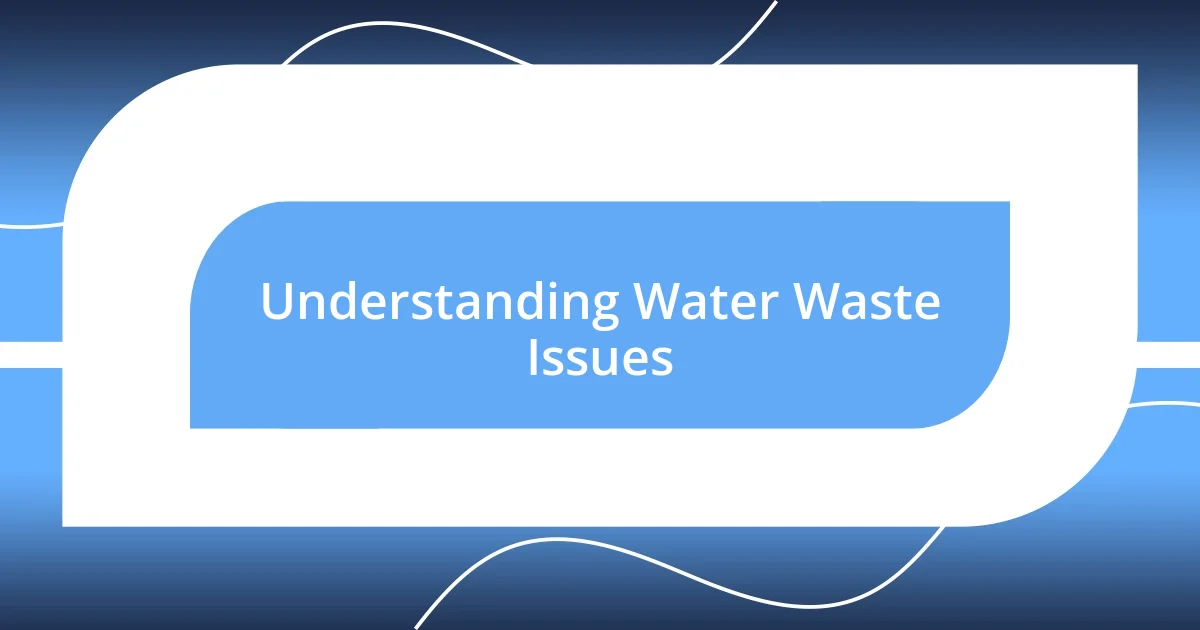
Understanding Water Waste Issues
Water waste is a pressing issue that often flies under the radar. When I first learned that the average person wastes about 30 gallons of water daily, I was shocked. This realization made me wonder: how often do I unknowingly contribute to this figure?
Think about it—every time we leave the tap running while brushing our teeth or take long showers, we’re throwing away a precious resource. I recall a moment when I calculated how much water my family used washing vehicles every weekend. It was eye-opening to see how quickly that added up! Reflecting on this, I often catch myself asking, “Is convenience worth the cost?”
This issue isn’t just numbers on a page; it’s about impact—both on our wallets and the environment. When I changed my mindset to view water as a limited resource, it transformed my daily habits. It reminded me that we’re all connected; when we waste water, we also waste the hard work and energy that goes into sourcing it.
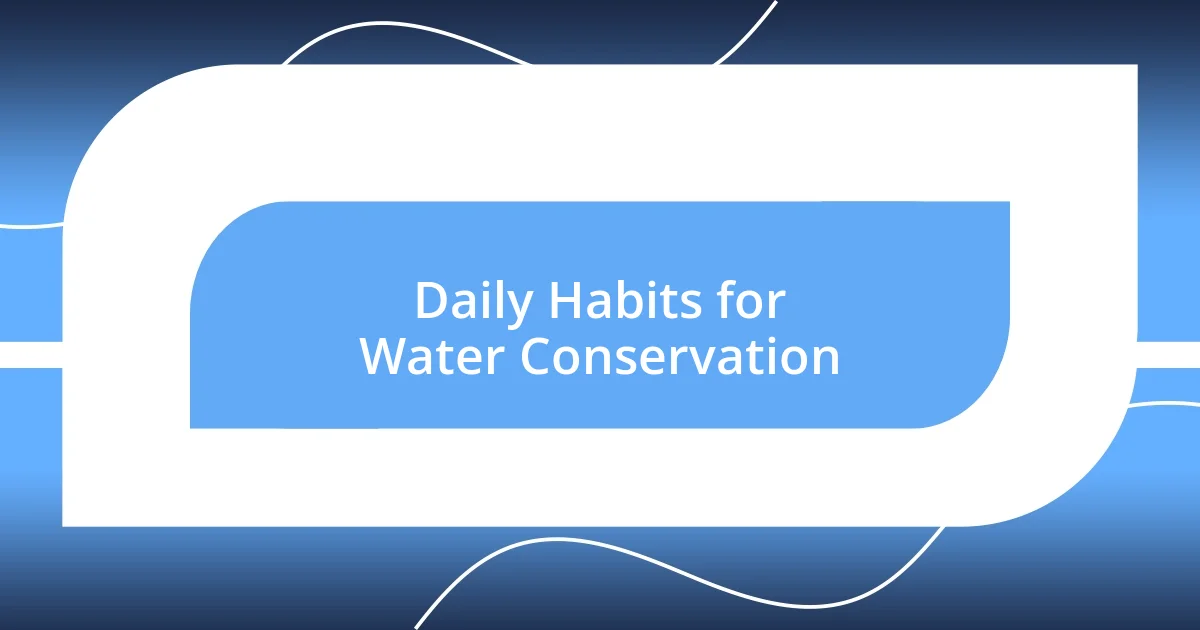
Daily Habits for Water Conservation
Daily habits can truly make a difference in reducing water waste. Personally, I’ve cultivated a practice of showering in under five minutes. At first, I was skeptical—could I really get clean in such a short time? To my surprise, it not only felt refreshing but also saved gallons of water each time I hopped in. It’s about getting intentional; I remind myself that every drop counts.
Another change I made is turning off the faucet while brushing my teeth. This simple switch has become second nature to me. I recall a time when I caught my young daughter leaving the water running without thinking. After we talked about why it’s important to conserve, she became my little water hero, reminding me to shut off the tap. Witnessing her newfound awareness was heartwarming, and it shows how daily habits can inspire others.
I also keep a pitcher of water in the fridge. Instead of running the tap until it’s cold, I pour from the pitcher. Initially, I thought it would be a hassle, but it turned out to be convenient. Plus, it has transformed my water consumption routine in a way I never anticipated.
| Habit | Description |
|---|---|
| Short Showers | Showering in under five minutes saves a significant amount of water. |
| Turn Off Faucet | Turning off the tap while brushing teeth prevents unnecessary water waste. |
| Chilled Water Pitcher | Using a pitcher in the fridge reduces faucet water usage for cold drinks. |
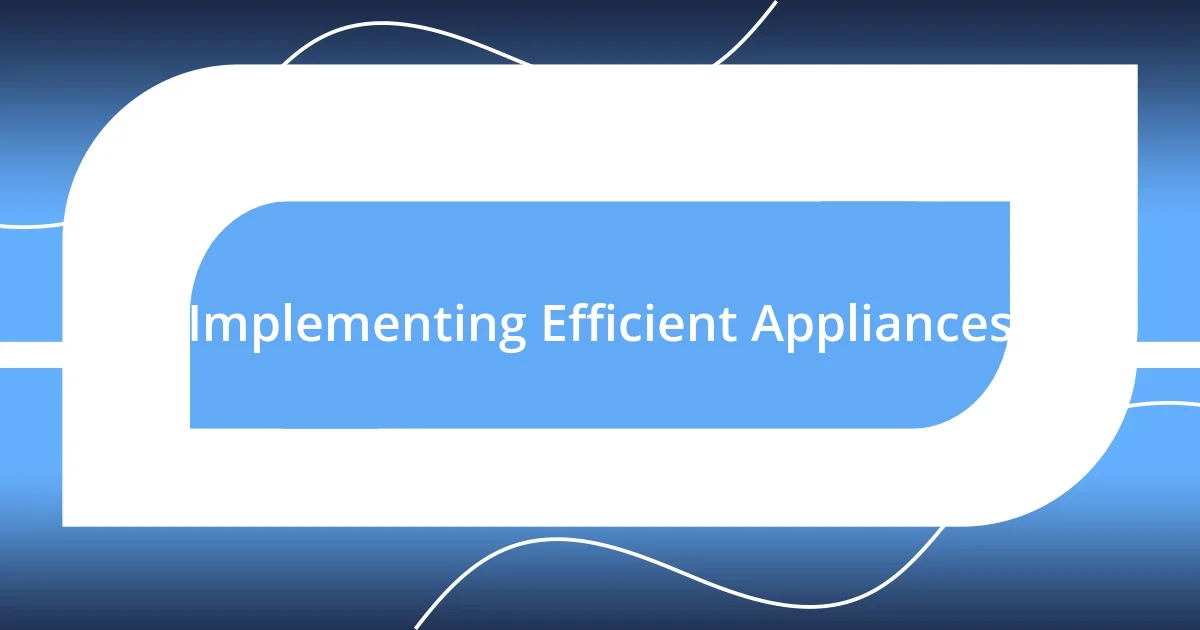
Implementing Efficient Appliances
Implementing Efficient Appliances
One of the most effective ways I’ve found to reduce water waste is by upgrading to efficient appliances. When I replaced my old washing machine, I chose a model that uses significantly less water per load. It turned out to be a win-win situation. Not only did it lower my water bill, but it also cleaned my clothes just as well—if not better—than my previous machine, leaving me feeling pleased with my choice.
Beyond just laundry, I’ve invested in low-flow fixtures for my faucets and showerheads. These fixtures provide a strong spray while using less water, which is key, especially for someone like me who loves a good, refreshing shower. I remember the first time I used my new showerhead; I was nervous it wouldn’t feel the same. To my delight, it felt invigorating!
Here are some appliances you might consider for a more water-efficient home:
- High-Efficiency Washing Machines: These models use up to 40% less water and energy than traditional machines.
- Low-Flow Showerheads: They maintain water pressure while reducing flow rate to save substantial amounts of water.
- Water-Saving Dishwashers: Modern models are designed to use less water and still deliver excellent cleaning power, helping you save on both resources and time.
- Dual-Flush Toilets: These toilets offer two flushing options, allowing you to use less water for liquid waste, making it a smart choice for any bathroom.
Implementing these efficient appliances has not only helped me become a more conscious water user, but it also brings me a sense of satisfaction knowing that I’m making a positive impact.
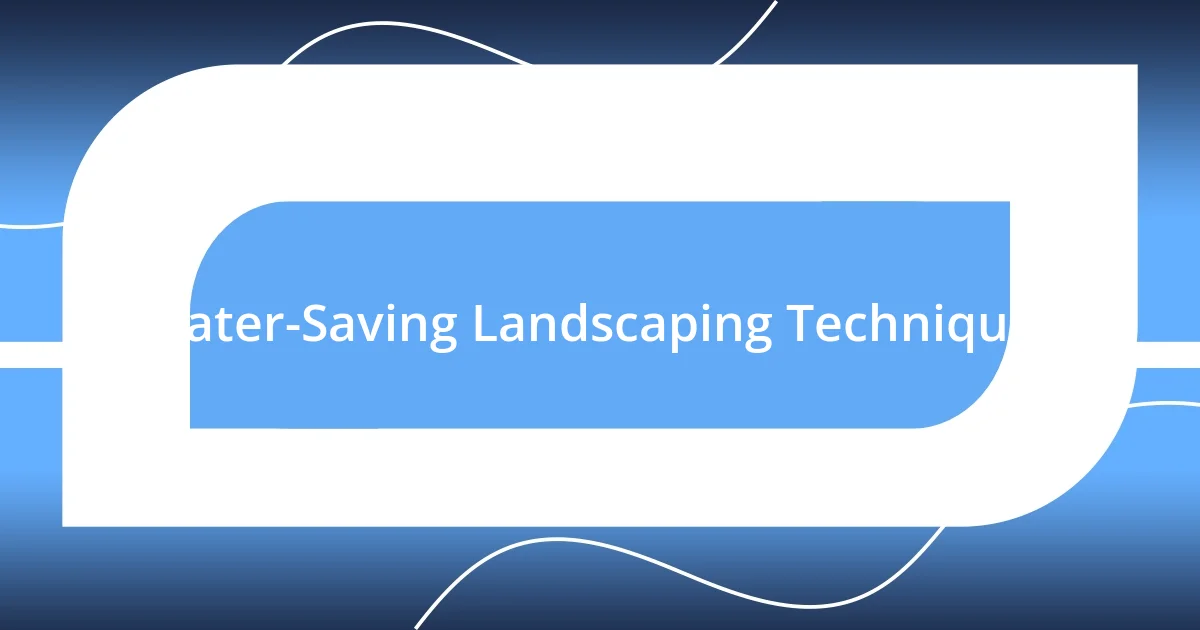
Water-Saving Landscaping Techniques
One of the most impactful changes I made to my landscaping was incorporating drought-resistant plants. Initially, I was worried that my garden would lack vibrancy, but I was pleasantly surprised. These hardy plants not only survived with minimal water but also thrived, creating a beautiful, diverse landscape that requires far less maintenance. Imagine not having to drag a hose around every week—what a relief!
I also embraced the use of mulch. Spreading a layer around my garden beds has proven to be a game changer. Not only does it help retain moisture in the soil, but it also suppresses weeds, which means I spend less time pulling them out. I remember the first time I mulched my flower beds—it was like applying a nourishing blanket that protected my plants from the heat. Watching the flowers bloom with bright colors without the constant need for watering made me realize that sometimes, the simplest solutions yield the best results.
Finally, installing a rainwater harvesting system has been a transformative experience. Each time it rains, I feel a sense of satisfaction knowing I’m capturing that precious resource. It’s incredible how quickly the barrels fill up with just a few storms, and using that water for my garden feels so rewarding. It makes me think, isn’t it wonderful to rely on nature’s own gifts rather than the tap? Each drop collected fuels my passion for sustainability while keeping my plants flourishing.
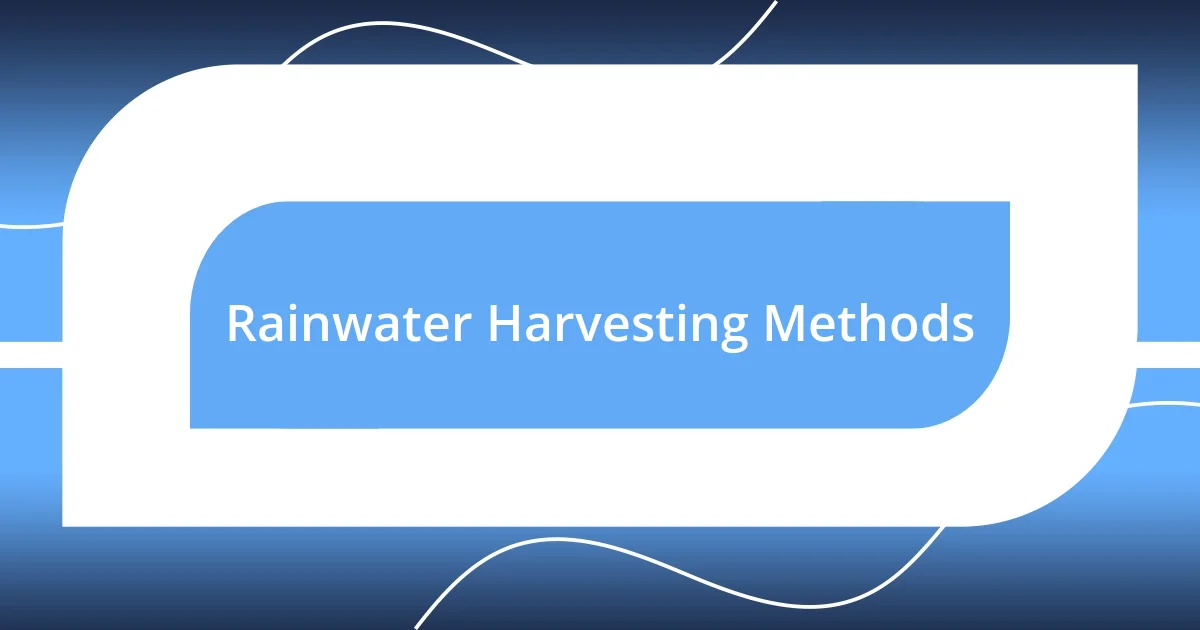
Rainwater Harvesting Methods
Rainwater harvesting is a fantastic method that I’ve embraced to not only reduce water waste but also to cultivate a more sustainable lifestyle. One method that works beautifully for me is the use of rain barrels. I remember the exhilaration I felt the first time I watched those barrels fill up after a downpour. It’s like collecting free water for my garden! I use that water for everything from watering my plants to washing my car, and knowing it came from the sky makes it feel more special.
I also installed a rain garden, which has become a charming feature of my yard. I was initially a bit apprehensive about how it would look, but the vibrant blooms and lush greenery have exceeded my expectations. Not only does this garden absorb runoff and reduce erosion, but it also attracts butterflies and birds, turning my outdoor space into a lively ecosystem. Every morning, I sip my coffee while enjoying nature’s symphony, and I can’t help but think about how small changes can lead to such delightful results.
Furthermore, I’ve experimented with DIY rainwater harvesting systems. It sounds complicated, but it’s surprisingly straightforward. One year, I connected a simple gutter system to a series of barrels. Every time it rained, I felt like I was harnessing a natural resource. Who would’ve thought I’d find such joy in being environmentally conscious? It’s rewarding to see how effective this method can be—it reminds me daily of the importance of conserving water in our ever-changing climate.
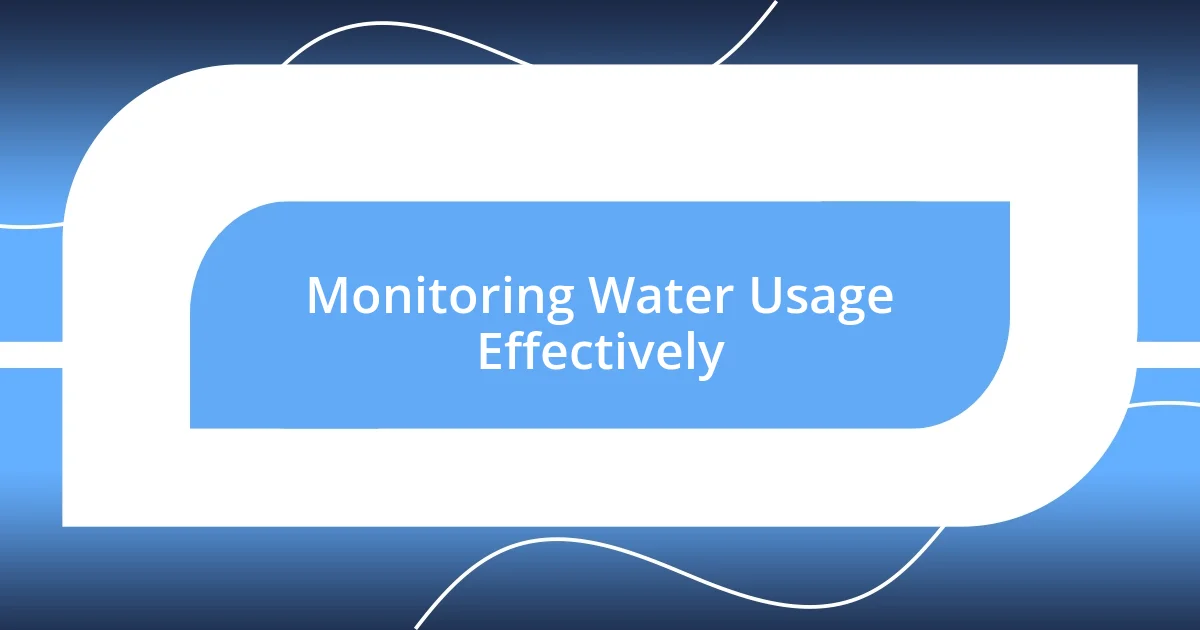
Monitoring Water Usage Effectively
When it comes to monitoring water usage effectively, I found that keeping track of my consumption has truly changed my perspective. I started using a simple tracking app to log my water usage daily, and to be honest, I was shocked by how much I was wasting without even realizing it. Each time I looked at the numbers, I felt a mix of disbelief and determination—it was a wake-up call that inspired me to be more mindful.
Additionally, I set up a system of water use reports to analyze patterns over time. I can now see which activities consume the most water and strategize on reducing those specific areas. For instance, it was eye-opening to discover that laundry was one of my biggest offenders. Now, I wait until I have full loads, which not only cuts down on water but also saves me on energy bills. Have you ever thought about how much difference small adjustments can make when they’re backed by data?
Lastly, I find joy in sharing my water-saving progress with friends and family. Not only does it hold me accountable, but it also sparks conversations about sustainability. Sometimes, during gatherings, I’ll share my monthly water usage statistics, and it’s fascinating to see their reactions. It encourages others to reflect on their own habits, fostering a supportive community focused on conservation. I often think, isn’t it powerful to inspire others through our own journeys?
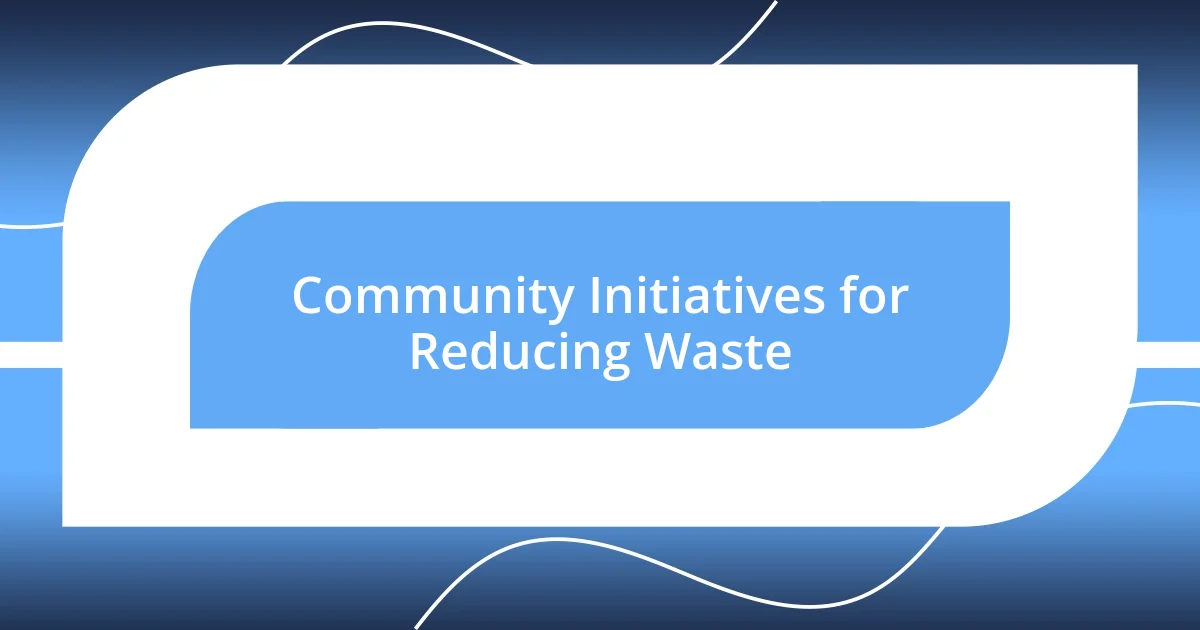
Community Initiatives for Reducing Waste
One initiative that has truly stood out in my community is the local water-saving challenge. I remember joining the challenge last year, which invited residents to track their usage and share tips. It felt like a friendly competition, and I was surprised at how motivated I became to find creative ways to save water. The camaraderie among neighbors really made the experience enjoyable—who knew that chatting over coffee could lead to discussions about low-flow showerheads and xeriscaping?
Another impactful program has been the community rain garden project. After attending a workshop, I teamed up with some neighbors to design and plant one in our local park. The sense of accomplishment we felt when our garden thrived was incredible! It wasn’t just about beautification; it transformed a previously puddle-ridden area into a vibrant space that supports local wildlife. Does anything feel better than knowing you’ve contributed to both your community and the environment?
Lastly, I’ve noticed how educational campaigns, like school outreach programs, encourage young folks to get involved in reducing water waste. My son brought home a project about water conservation that sparked his interest in nature. It made me reflect: how often do we overlook the power of education in motivating change? Seeing kids passionately discussing simple habits, like turning off the tap while brushing their teeth, fills me with hope for the future. Ultimately, these community initiatives not just reduce water waste but weave a tapestry of shared purpose and connection among us all.












